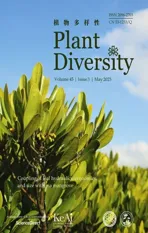The life of Xuan Zhou, founding father of the Gastrodia elata cultivation and industry in China
2023-07-11JianWang
Those familiar with Gastrodia elata Blume (Tianma, 天麻) in China will most certainly recognise the name of Xuan Zhou (周铉), the first postgraduate student of Professor Zheng-Yi Wu (吴征镒), widely respected professor of botany and an academician of the Chinese Academy of Sciences (Peng et al., 2013).
Xuan Zhou (abbreviated S.Chow in taxonomic citations, also Chou, Hsüan in Wade-Giles transliterations) (Fig.1) was born in Xinzheng, in the central Chinese Province of Henan on 4 May 1926.He graduated from Tongji University in 1951.He took part in and successfully passed the first national post-graduate examination held by the Chinese Academy of Sciences in 1956 and became a candidate for an Associate Doctor degree (equivalent to MSc) under the tutelage of Prof.Wu.
In 1960 Zhou and his family followed Prof.Wu from Beijing to the then remote frontier province of Yunnan,where he commenced work at the Kunming Institute of Botany, Chinese Academy of Sciences.He was employed as a research assistant, research fellow,and associate professor.He was later appointed as the leader of the Plant Morphology Section within the Institute, a position he held until his retirement in 1986.
During his early career,Zhou developed a deep interest in natural resources.This saw him not only contributing to the taxonomy of Lamiaceae for the Flora of China,but also dedicating more than 50 years of his life to the scientific research and promotion of Gastrodia elata.
From 1960 to 1966, he not only produced his early scientific monograph “The Origin and Development of Plant Taxonomy”, but also named a new subfamily Wenchengioideae (co-authored with Prof.Wu), two new genera, Wenchengia (co-authored with Prof.Wu) and Holocheila, 13 new species, two new combinations and three new varieties (mostly co-authored with Prof.Wu) in Lamiaceae and Orchidaceae (Supplementary data).The two new genera,which are now considered basal lineages of Scutellarioideae and Pogostemoneae of Lamioideae in Lamiaceae, respectively (Zhao et al.,2021;Zhou et al.,2022),were published in Acta Phytotaxonomica Sinica(now Journal of Systematics and Evolution)and accepted in the Flora of China (Vol.65).As a result, “Taxonomy, Geography and Evolution of Chinese Lamiaceae”was awarded Second Prize in National Natural Science of China in 1993.Zhou was one of the awardees along with Prof.Wu and others.Zhou was also elected as a committee member of the Chinese Academy of Sciences’Department of Biology in 1983 and took part in planning the“Chinese National Biological Strategy from the year 1985-2000 and beyond”.
Gastrodia elata,which is known as Tianma in Chinese and“heavenly hemp”in Asia, is a fully mycoheterotrophic perennial herb in the family Orchidaceae.This herb has been shown to contain a significant number of pharmaceutical compounds (Zhang and Yang,2007).Its tubers have long been used in traditional Chinese medicine,treating a wide range of conditions,as an anticonvulsant,analgesic,sedative,anti-asthma,and pro-immunity drug.In addition,it is served in nutritious dishes.
Before Zhou’s research, the supply of Tianma was completely dependent on wild harvests.Population growth in the 1950s and early 1960s led to the demand for Tianma that far exceeded its supply.Despite previous efforts,very little progress had been made in the propagation and cultivation of the plant.
In 1966 Zhou began field trials and experiments aimed at cultivating Tianma in the mountainous forests of Xiaocaoba Town,Yiliang County, Zhaotong Prefecture of Yunnan Province.The climate of Xiaocaoba, which is characterized by high humidity and minimal sunshine, produces the highest-grade Tianma crop in the world.
Zhou’s world became associated with, and dominated by Tianma (Fig.S1).From 1966 to 1979, he worked at Xiaocaoba and devoted almost all his time to field experiments.He even spent five Chinese Spring Festivals in his forest cottage at Xiaocaoba(Fig.S2), investigating germination, protocorm formation, and tuber growth and development in Tianma.The people of Xiaocaoba called him Zhou Tianma.
In 1968 Zhou made a significant breakthrough, becoming the first researcher to discover Tianma’s method of sexual reproduction.He conducted seedbed sowing trials (Fig.S3) the following year and achieved significantly satisfactory germination rates in 1970.
Despite the successful results,local villagers were still dubious.There was a traditional belief that the plant is a gift from the heavens.To persuade villagers of the benefits of Tianma cultivation,Zhou compiled a poetry-style folk rhyme called‘A Song for Planting Tianma’.He summarised the process and made several more publications regarding the versatile and valuable herb (Chou, 1973,1974; Zhou,1979,1981,1983; Zhou and Chen,1983).His purpose was not only to distinguish the species from similar species, but also to further elucidate the importance of reproduction and the nutritional needs of Tianma.He believed that once the villagers learned more about the complexity of the symbiotic relationships required for Tianma's survival, they would grow it successfully.

Fig.1.Xuan Zhou (4 May 1926-15 January 2023).
In 1978,Zhou was honoured as an“Advanced Worker of the Science and Technology Commission of Yunnan Province”.He also won second prize for scientific research in Yunnan Province.In 1988 his “Comprehensive Research on Gastrodia in China”won third prize in the Science and Technology Progress Award of Yunnan Province.In 2002,the monograph“The Morphology of Gastrodia elata”(Zhou et al.,1987) won him a special allowance from the Government of Yunnan Province.
Zhou was acknowledged as“The Founding Father of the Sexual Propagation of Gastrodia elata”.After retirement, he travelled to many provinces in China, especially to those areas where conditions matched the growth requirements of Tianma.He generously donated his technique to anyone who needed it to grow the plant.He maintained that his scientific knowledge should always be shared, especially at a regional level.In 2012, he was given a Lifetime Achievement Award by the Mycological Society of China.
Zhou devoted more than 50 years of his life to research and promote Tianma.His discovery of its method of sexual reproduction empowered many people living in mountainous rural regions to improve their economic conditions and enjoy a better standard of living.His research also emphasised the importance of protecting the species, which would otherwise have been harvested close to extinction in the wild.Currently, in Zhaotong Prefecture alone,Tianma production generates five to ten billion CNY (≈1 billion USD) in economic benefits each year.
In 2019,both the Central and Yunnan Committees of the Jiusan Society awarded Zhou the title“Jiusan Model”in honour and recognition of his scientific achievements.
Zhou regarded Yiliang,where he worked for 13 years,as his second hometown.He was recognised as an “Honorary Citizen of Yiliang County”by the Yiliang Government in 2014.In the same year, a sculpture of his likeness was erected in the Yiliang Exhibition Centre (Fig.S4), celebrating his contribution to Tianma research.Now in the wake of his passing on 15 January, 2023,this statue remains as a memorial to a life dedicated to his work and to his countrymen.
Conflicts of interest
The author declares that he has no conflict of interest.
Acknowledgements
I would like to thank Prof.De-Zhu Li for encouraging and commenting, Shu-Guang Wu and Wei-Ping Zhou for providing information, Dr.Jian-Wen Zhang for technical assistance, Jill, Tony, Alie and Geoff for friendly editing.
Appendix.A.Supplementary data
Supplementary data to this article can be found online at https://doi.org/10.1016/j.pld.2023.03.010.
猜你喜欢
杂志排行
植物多样性的其它文章
- Honoring a legend: Celebrating the life and legacy of Professor Heng Li
- Siwalik plant megafossil diversity in the Eastern Himalayas: A review
- Global patterns of taxonomic and phylogenetic diversity of flowering plants: Biodiversity hotspots and coldspots
- Distribution and conservation of near threatened plants in China
- Insights into cryptic speciation of quillworts in China
- Patterns of floristic inventory and plant collections in Myanmar
